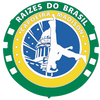 A playful game (jogo) of capoeira
A playful game (jogo) of capoeira
Capoeira (pronounced ka-poe-AE-rha) is a Brazilian art form that fuses self defense, dance, music and acrobatics. It is said to be a child conceived in Africa but born and raised in Brazil. It was born as a form of self-liberation for African slaves against their Portuguese slave masters and as such, it had to be disguised through music and dance so as not to reveal its true martial nature. Having survived the abolition of slavery in Brazil in 1888, Capoeira continued to be illegal and associated with gang warfare until the 1930’s when it was taken off the streets and brought into the classroom. From that point until today, Capoeira has grown in popularity and come to be known in and outside of Brazil as a rich ambassador for the Brazilian culture.
In spite of its history, Capoeira is a playful art form. The very verb used in Portuguese to practice Capoeira is jogar or to play. It is always played in a circle, or roda (pronounced: ho-da), where the participants are both the musicians and the players. Call and response singing is accompanied by an atabaque (drum), pandeiro (tambourine), and berimbau. The bow-like instrument, or berimbau, commands the rhythm of the roda and of the games that are played. Within the roda, the game is a conversation between two people using the language of Capoeira, testing one another’s skills with a combination of rhythmic movements, kicks, and dodges. Nothing is choreographed.
Capoeira is an incredibly rich and multi-dimensional art—a means for learning a new culture, language and body expression. It teaches its practitioners strength, grace, flexibility, quick reflex and spontaneity. As many actions and songs in Capoeira are best not to translate, it teaches the cadenced language of Portuguese and with it the culture of Brazil. Above all, it joyfully challenges us to link our body’s movements with our mind and the music—a union that creates beautiful results both in the Capoeira roda and in our outside lives.
The roda, or circle, where capoeira is practiced, is a metaphor for life. At different stages in our lives, we have different skills that we focus on. As such we believe that whether one approaches capoeira through its history, movement or the music, everyone has access to this rich and beautiful art form.
Ready to start? Check out our Classes.
In spite of its history, Capoeira is a playful art form. The very verb used in Portuguese to practice Capoeira is jogar or to play. It is always played in a circle, or roda (pronounced: ho-da), where the participants are both the musicians and the players. Call and response singing is accompanied by an atabaque (drum), pandeiro (tambourine), and berimbau. The bow-like instrument, or berimbau, commands the rhythm of the roda and of the games that are played. Within the roda, the game is a conversation between two people using the language of Capoeira, testing one another’s skills with a combination of rhythmic movements, kicks, and dodges. Nothing is choreographed.
Capoeira is an incredibly rich and multi-dimensional art—a means for learning a new culture, language and body expression. It teaches its practitioners strength, grace, flexibility, quick reflex and spontaneity. As many actions and songs in Capoeira are best not to translate, it teaches the cadenced language of Portuguese and with it the culture of Brazil. Above all, it joyfully challenges us to link our body’s movements with our mind and the music—a union that creates beautiful results both in the Capoeira roda and in our outside lives.
The roda, or circle, where capoeira is practiced, is a metaphor for life. At different stages in our lives, we have different skills that we focus on. As such we believe that whether one approaches capoeira through its history, movement or the music, everyone has access to this rich and beautiful art form.
Ready to start? Check out our Classes.

